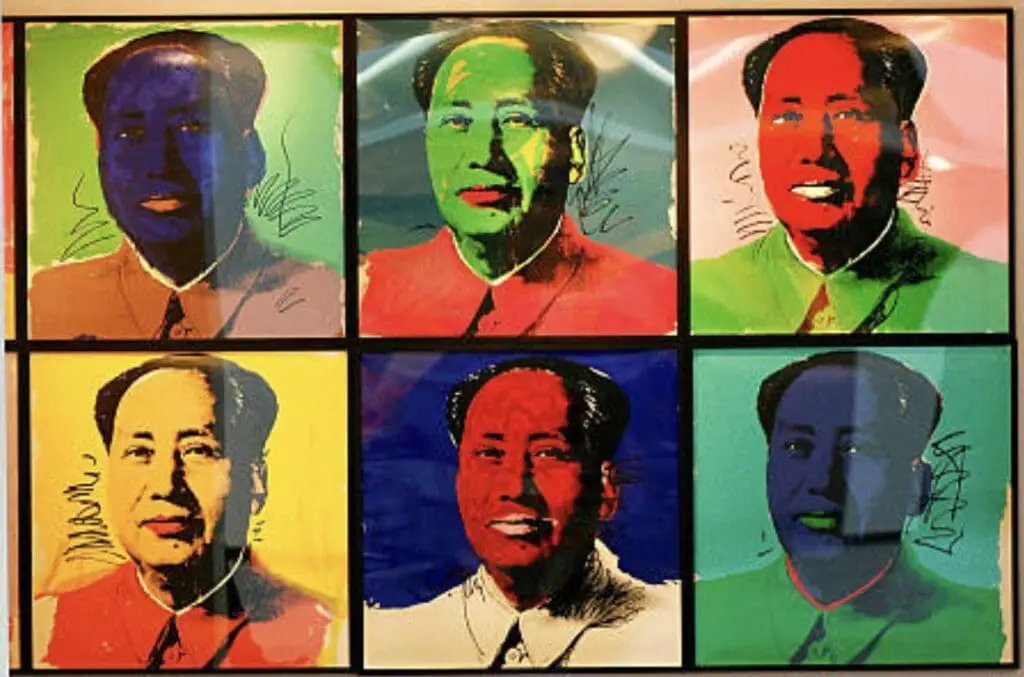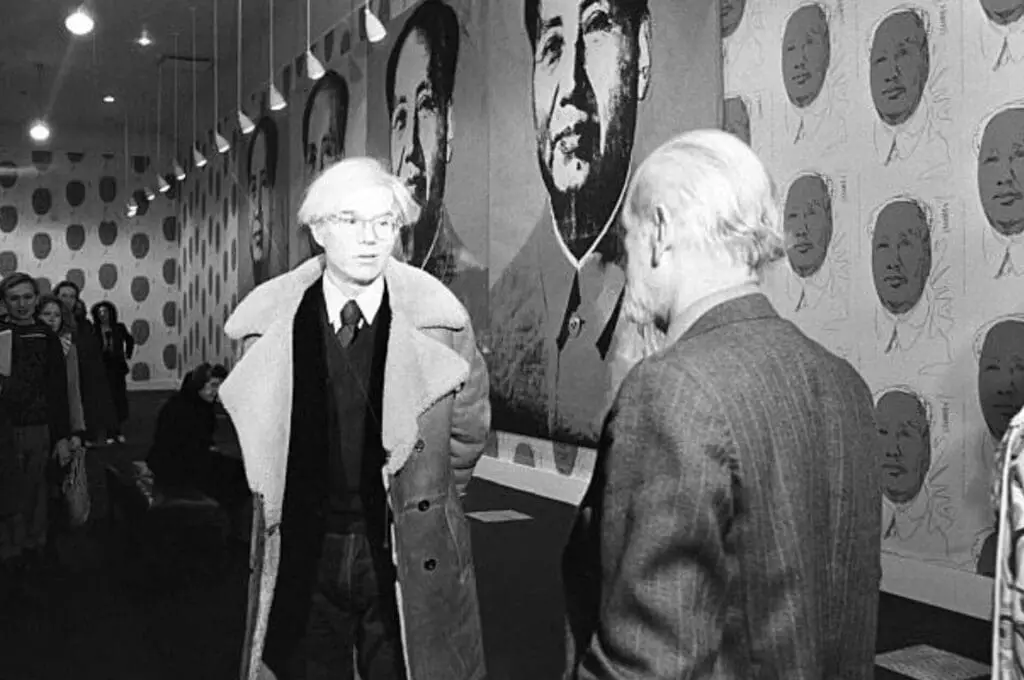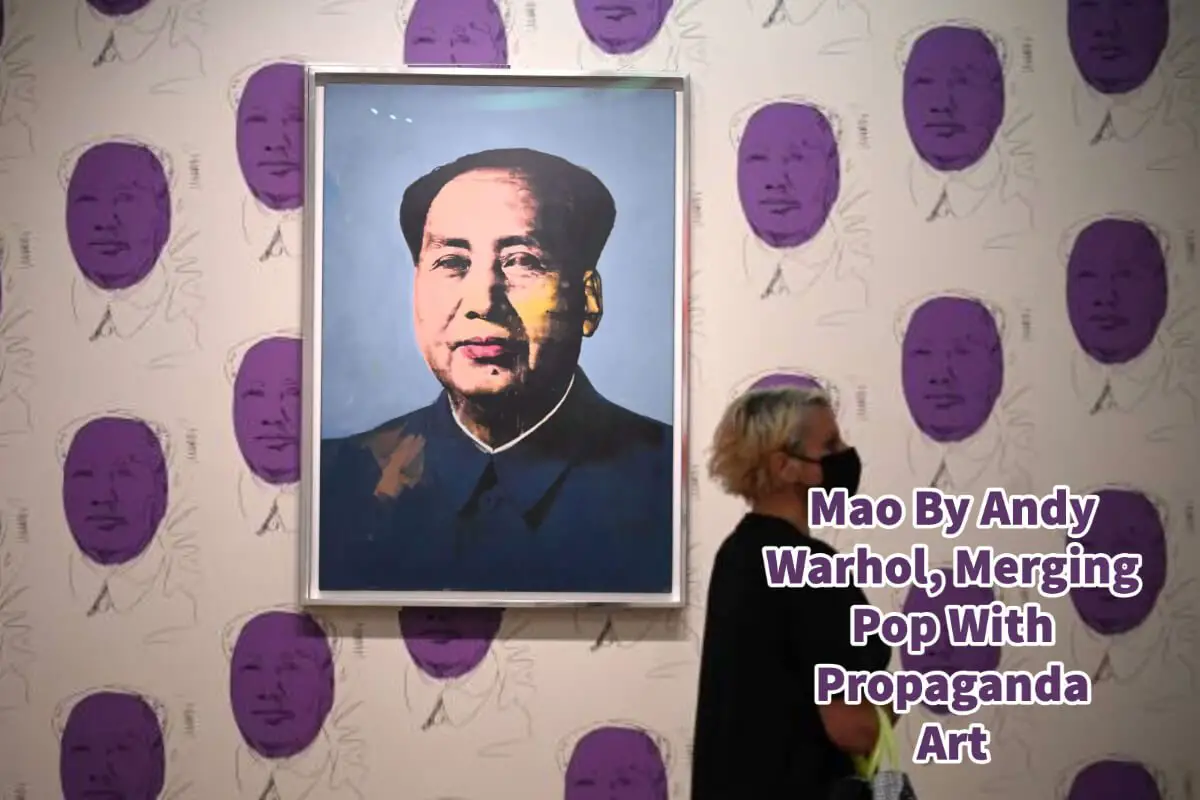American artist Andy Warhol remains a titan in Pop Art, forever memorialized for his paradoxical juxtaposition of mass culture and art, mysterious persona, and exploration of the fragile boundaries between fame and anonymity. As a chronicler of modern times,
Warhol merged different art styles with an audacity transcending conventional artistic discourse. One of the most profound examples of this is his masterpiece, Mao, a series of 199 portraits of Chairman Mao Zedong, which, through its intriguing amalgamation of Pop Art and propaganda art, invited an intellectual inspection of the era’s prevailing social dynamics.
Table of Contents
- About The Mao Series By Andy Warhol
- Similarities Between Western Pop Art And Communist East
- Imposing Portraits Of Mao
- Warhol Used Garish And Bright Colors In Mao Series
- Warhol Used Bold Strokes In The Mao Painting
- Mao Is A Brillant Merge Between Pop Art And Propaganda Art
- Symbol Of Artificiality
- Mao Series Shows Warhols Personality And Worldwide
- Mao Series Converged Pop With Propaganda Art
- Warhol’s Mao Series Helps Us Reflect On Warhol As An Artist
- Frequently Asked Questions
- Related Questions
About The Mao Series By Andy Warhol
The Mao series, first displayed in 1972, was a bold, unprecedented undertaking, especially given the political climate of the time. The United States and China were at loggerheads, their diplomatic relationship in its infancy, following President Richard Nixon’s historic visit to Beijing.

Warhol’s decision to create portraits of the Chinese leader was seen as a controversial comment on the growing fascination with Mao’s cult of personality in China and the West.
Warhol’s signature style of employing mass production techniques for art served as a commentary on the prevailing culture of consumerism. With Mao, he replicated this practice, creating a string of images that mimicked the ubiquity of Mao’s portraits in China, where they were displayed in homes, offices, and public squares.
Similarities Between Western Pop Art And Communist East
This artistic decision pointed to the similarities between the mass consumer culture in the capitalist West and the propaganda-driven imagery of the communist East. His ironic mirror of totalitarianism through his Pop Art lens challenges viewers to confront the essence of propaganda and the power of image control.
Imposing Portraits Of Mao
Nearly fifteen feet tall, the towering work harkens back to the colossal statues and omnipresent images of Mao Zedong displayed throughout China during the Cultural Revolution. The gigantic proportions also reflect the enormity of Mao’s influence and how it dwarfed the individual in Chinese society.
Through this towering figure, Warhol unveils an inherent contradiction of the piece – its impressive scale indicates Mao’s pervasive presence in China. Yet, its repetition reveals a certain redundancy and impersonality, underscoring the manufactured nature of Mao’s public persona.
Warhol Used Garish And Bright Colors In Mao Series
In direct contrast to the photographic fidelity of the image, Warhol liberally employs garish colors on Mao’s face, reminiscent of makeup or perhaps theatrical masks, emphasizing the superficiality of Mao’s image as propagated by the Chinese government. The stark difference between the realistic photographic image and the artificial, fluorescent colors creates a disturbing effect.
It is almost as if Warhol is simultaneously presenting and dismantling Mao’s omnipotent image – demonstrating both the immense power of a propagated personality and the artificial construct behind such a persona.
The color palette itself deserves special mention. The bright hues are characteristic of Warhol’s Pop Art aesthetic, which often appropriated the colors and motifs of advertising and commercial imagery. However, in the context of Mao, these colors gain an extra layer of meaning.
They don’t just mock the staid, severe image of Mao commonly depicted in Chinese propaganda; they also undercut the serious, monochromatic palette typically associated with political portraiture. This colorful subversion is Warhol’s commentary on the nature of political power and the thin line separating reverence and satire.
Warhol Used Bold Strokes In The Mao Painting
Warhol’s handling of color in Mao shows him at his most painterly, a departure from his usual machine-like precision in silkscreen printing. His strokes are almost aggressive, vigorous, and bold, unlike his delicate, almost invisible hand in his other works.
This apparent deviation from his usual style could be interpreted as Warhol’s response to the weighty subject of his work, underlining the emotion and tension surrounding the political figure of Mao Zedong.
Mao Is A Brillant Merge Between Pop Art And Propaganda Art
Andy Warhol’s Mao is a masterstroke, a brilliant confluence of Pop Art and propaganda art that reflects the artist’s profound understanding of contemporary society and its imagery. It is a commentary on the cult of personality, the power of repetition, and the thin line that separates commercialism and propaganda.

It studies contrasts – reality vs. facade, individual vs. collective, and mass culture vs. high art. This rich dichotomy of themes ensures Mao’s place as a pivotal work in Warhol’s oeuvre and an essential contribution to the global art narrative.
The iconic image of Mao, forever imprinted with Warhol’s signature style, continues to resonate, epitomizing the artist’s fascination with fame, power, and the many faces they wear.
Symbol Of Artificiality
Even as Warhol underscores the plastic artificiality of Mao’s portrayed image, there’s an undercurrent of acknowledgment that this artificiality has a real and tangible impact. Warhol’s rendition of Mao can’t be detached from the reality that this constructed persona ruled China, shaping millions’ lives. His artwork, therefore, also compels us to scrutinize the consequences of such powerful propaganda.
In that sense, Mao can be viewed as a critical examination of the psychological mechanisms behind political iconography. Warhol achieves this through the choice of his subject and his signature style.
By replicating Mao’s image in various forms, colors, and expressions, he dilutes the awe and fear that typically accompanies such influential figures, simultaneously humanizing and trivializing Mao.
This methodology exposes the mechanics of propaganda, often relying on deifying a single, immutable image.
Mao Series Shows Warhols Personality And Worldwide
The artwork is also a reflection of Warhol’s philosophy and worldview. He once famously said, “In the future, everyone will be world-famous for 15 minutes.”
In that context, Mao can be interpreted as an exploration of transitory fame in the political sphere, offering a stark contrast to Warhol’s previous subjects – icons of popular culture and celebrities who, despite their public prominence, held significantly less political power than Mao.
Mao Series Converged Pop With Propaganda Art
The idea of merging Pop Art with propaganda art was not a prevalent practice when Warhol created the Mao series. However, Warhol was no stranger to traversing the unknown.
He was already a master at blurring the lines between high art and popular culture. With Mao, he pushed the envelope further by blurring political and artistic boundaries. Warhol’s portrayal of Mao is not just a fusion of two distinct styles but a testament to his ability to defy genre classification and redefine art paradigms.
Moreover, Warhol’s Mao challenges the perception of art’s role and function. The series raises questions about the function of art in a political context.
Is it merely a reflection of the times, or can it actively shape perceptions? Does it merely present a narrative or critique it? Through the Mao series, Warhol prompts these questions without providing clear answers, leaving the interpretation open to the viewer.
Warhol’s Mao Series Helps Us Reflect On Warhol As An Artist
Warhol’s Mao also pushes us to revisit and re-evaluate our understanding of him as an artist. Often considered detached and emotionless, through Mao, we see Warhol taking on a politically charged topic, showcasing a subtle sensitivity to global affairs and their sociopolitical implications.

The Mao series, therefore, is not just a visual spectacle but a nuanced socio-political commentary. It is a vivid manifestation of Warhol’s artistic vision that dared to question, challenge and reinvent.
He took the familiar – a face that had become a constant in China. He transformed it into an object of contemplation, highlighting the complex interplay between politics, propaganda, and pop culture.
Through Mao, Warhol illustrates the power of art – its ability to provoke thought, question established narratives, and etch indelible imprints on the collective consciousness of societies.
It encapsulates Warhol’s genius and boldness, providing us with a decadent visual treat while engaging us in an intellectual dialogue – a testament to Warhol’s enduring relevance and the timeless power of his art.
The painting’s appeal lies not only in its immediate visual impact but also in the depth of its commentary on fame, power, and propaganda – themes that resonate even more in today’s hyper-connected world.
Anita Louise Art is dedicated to art education, great artists, and inspiring others to find and create their art. We love art that uplifts and inspires. #ArtToMakeYouSmile! #ArtToMakeYouHappy!
If you want to see any of my art, you can find out more by clicking here. If you are interested in what inspires me and my paintings, you can discover more by clicking here.
We have a free newsletter and would love you to be part of our community; you can subscribe to the newsletter by clicking here. If you have any questions, I would be happy to talk to you. You can reach me, Anita, by clicking here.
Subscribe to our Anita Louise Art YouTube Channel, filled with great videos and information by clicking here.
Join us for our podcast “5 Minutes With Art.” Spend 5 minutes a week with us to discover and learn about great art and artists. You can find out more about our podcast by clicking here.
Frequently Asked Questions
What inspired Andy Warhol to create the Mao series?
Andy Warhol’s fascination with fame, mass media, and political figures converged in the Mao series. The series, created in the early 1970s, was a response to the iconic status of Chairman Mao Zedong and the global political climate of the time.
How did Warhol merge Pop Art with propaganda in the Mao series?
Warhol merged Pop Art techniques, such as vibrant colors and repetition, with the imagery of Chairman Mao, creating a visual dialogue between mass culture and political power. The use of Mao’s image, a symbol of political authority, in a Pop Art context blurred the lines between high and low culture.
What significance does the Mao series hold in the context of Warhol’s exploration of fame and anonymity?
The Mao series reflects Warhol’s consistent theme of celebrity culture. By depicting a powerful political figure, Warhol questioned the nature of fame, its transience, and the tension between individual identity and the larger cultural context.
How did Warhol’s Mao series engage with contemporary social dynamics?
During the Cold War era, Mao Zedong was a prominent figure, and Warhol’s Mao series can be seen as a commentary on the intersection of politics and popular culture. The series captured the global fascination with political figures and their influence on the collective consciousness.
Did Warhol’s Mao series face any controversy or criticism?
Yes, Warhol’s Mao series sparked controversy due to its use of a political leader’s image in an artistic context. Some viewed it as a subversive commentary on political power, while others criticized it for potentially glorifying a controversial political figure.
How did Warhol’s Mao series contribute to the evolution of Pop Art?
The Mao series expanded the boundaries of Pop Art by introducing political subject matter into a genre primarily associated with consumerism and popular culture. Warhol’s approach demonstrated that Pop Art could be a platform for social and political commentary.
What artistic techniques did Warhol employ in the Mao series?
Warhol utilized his signature silkscreen printing technique, repetition, and bold color choices in the Mao series. These techniques, synonymous with his Pop Art style, gave the portraits a visually striking and impactful quality.
How did the Mao series reflect Warhol’s interest in mass production and consumer culture?
The repetitive nature of the Mao series echoed Warhol’s fascination with mass production and consumer culture. By reproducing Mao’s image numerous times, Warhol highlighted the commodification of political figures and the widespread dissemination of their images.
Did Warhol’s Mao series have an impact on political art in subsequent decades?
Yes, Warhol’s Mao series influenced the trajectory of political art, inspiring artists to engage with political themes in unconventional ways. The series demonstrated that even political figures could become subjects of artistic exploration and critique.
How does the Mao series fit into Warhol’s broader body of work and artistic legacy?
The Mao series is a testament to Warhol’s ability to merge seemingly disparate elements—Pop Art and political imagery—in a way that challenges traditional artistic boundaries. It remains a significant part of Warhol’s legacy, showcasing his unique perspective on the interplay between art, culture, and politics.
Related Questions
Is There Any Painting Of The Young Leonardo da Vinci?
There is a painting by Giovanni Cariani (c. 1490-1547) at the National Gallery of Art, Washington DC, called Portrait of Man With a Dog (1520) that some people have said a painting of the younger Leonardo. Leonardo would have already been dead by the time this painting was completed. There is also a little-known artwork called Romanzo di Paolo e Daria by Gaspare Visconti that some feel is making fun of Leonardo da Vinci and his red hair.
By clicking here, you can learn more by reading Is There Any Painting Of The Young Leonardo da Vinci?.
What Inspired Leonardo da Vinci To Paint The Last Supper?
Duke Ludovico Sforza commissioned Leonardo to paint the Last Supper mural. What makes the Last Supper mural so unique is that he painted it at the exact time when Christ told the Apostles during The Last Supper meal that one of them would betray him. Leonardo showed the apostles’ reactions, including Judas, who betrayed Christ.
By clicking here, you can learn more by reading What Inspired Leonardo da Vinci To Paint The Last Supper?
Mona Lisa Painting And The Paris Louvre Museum
The Mona Lisa is one of the key paintings of the Louvre Museum. It is one of the most visited paintings in the world. The Mona Lisa is a painting studied, sung about, written about, and spoken about. There is still a mystery surrounding exactly who the Mona Lisa is and why Leonardo da Vinci painted it. This mystery adds to the allure of the painting.
By clicking here, you can learn more by reading Mona Lisa Painting And The Paris Louvre Museum.

